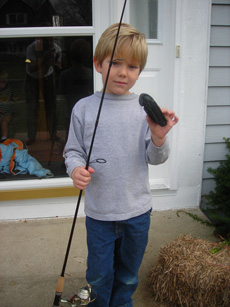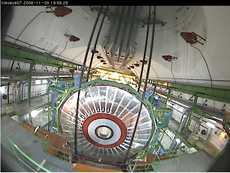|
Fri., December 1
3:30 p.m. Director's Coffee Break - 2nd floor crossover
4:00 p.m. Joint Experimental Theoretical Physics Seminar - 1 West
Speaker: B. Stelzer, University of California, Los Angeles
Title: Status of Single Top Analysis on CDF
8:00 p.m. Arts and Lectures Series - Auditorium - $5
Speaker: D. Harris
Title: Neutrino Beams at Fermilab: The Fastest Way Between Here and Minnesota
Mon., December 4
2:30 p.m. Particle Astrophysics Seminar - Curia II
Speaker: E. Lim, Yale University
Title: Large Non-Gaussianities from Single Field Inflation
3:30 p.m. Director's Coffee Break - 2nd floor crossover
4:00 p.m. All Experimenters' Meeting - Curia II
Special Topics: SciBooNE Construction Progress
Tevatron Low-Beta Optics Measurements and Upgrade Plans
Click here for NALCAL, a weekly calendar with links to additional information. |
Friday, December 1
-New England Clam Chowder
-Black & Blue Cheese Burger
-Mardi Gras Jambalaya
-Swedish Meatballs
-Bistro Chicken & Provolone Panini
-Assorted Slice Pizza
-Carved Top Round of Beef
Wilson Hall Cafe Menu |
|
Wednesday, December 6
Lunch
Catfish Fillet with Coarse Mustard Sauce
Roasted Corn and Red Pepper
Tomato Rice Pilaf
Chocolate Pecan Tart
Thursday, December 7
Dinner
Steamed Mussels in White Wine, Garlic & Thyme
Veal Marsala
Orzo with Pine Nuts
Sautéed Spinach with Lemon Zest
Pear Hazelnut Soufflé
Chez Leon Menu
Call x4598 to make your reservation. |
|
|
Too many pages?

Noah Jansson doesn't like to throw back his catches. So when the five-year-old went fishing last week at Fermilab and caught a cell-phone, he kept it. "My son cast out his line and said "oh it's stuck," maybe 20 feet out in the water," said father Andreas Jansson. "He'd hooked on a cell phone with a leather case."
Jansson senior, who is Swedish, came to Fermilab four years ago to work in the Tevatron Department. He says his son became interested in fishing after catching a pike on vacation. "Back home in Sweden he caught a tiny little pike--probably about five inches long and an inch wide," said Jansson. "He was pretty excited and insisted on eating it, but didn't taste too good."
After that trip, the father and son started fishing in the Fermilab ponds, and last Saturday they decided to take advantage of the nice weather and fish again. They were used to catching bass, bluegill and catfish at Fermilab--but a cell phone they were not planning on. "It's funny that there was a cell phone 20 feet out in the lake," said Jansson. "Someone must have thrown it....Maybe they got paged too much."
--Siri Steiner |
Butter in the beam
Dave Harding of the Technical Division responded to a reader's question.
Dear FT:
I have been pondering a scientific question:
What would happen if someone stuck a stick of butter into a particle accelerator?
Regards,
Aaron M. Boruff
Dear Aaron,
The short answer is that you would mess up the butter, you would mess up the beam of particles, and you would mess up the accelerator. In case you want to know more, I'll tell you a little about how each of those would happen.
First, we'll look at the butter. Every time one of the fast-moving particles in the accelerator would go though the stick of butter, the particle would kick some of the electrons in the atoms of the butter, giving them energy. (The nuclei of the atoms would also get a little energy, but not nearly so much.) The electrons' energy would become heat in the butter, first warming up the part of the stick that the beam was going through, then melting it, and finally vaporizing it. Depending just which accelerator the butter was in and how hard we were running it, we would make a hole through the stick in around a millisecond, give or take a few factors of ten, messing up the butter.
What about the particle beam? As the particles traveled through the butter, they would be nudged a little in random directions, so they would start to spread out. The beam would get bigger. At the energies Fermilab runs at, this wouldn't be a very large effect the first time through the butter, but most of our accelerators are rings where the particles loop around and around. Even with just a little nudge each time around, quite quickly the beam would grow to the point that it would scrape on the walls of the accelerator and be lost, messing up the beam.
Finally we must consider what a stick of butter might do to the accelerator. From what I have already said, you can tell that having anything in the beam of particles is generally not a good idea for running the accelerator. In fact, this is so important that we even try to suck all air out of the pipe that the beam travels in so that the particles don't scatter from the air molecules, let alone the molecules in a stick of butter. We have several kinds of fancy pumps to pull the air molecules out, but we have to start with very clean pipes. After cleaning components, we wear gloves when we handle anything that will go into the accelerator because the oil in our fingerprints gets into pipes, floats around, and disturbs the particle beam. You can imagine that a whole stick of butter would create a colossal mess.
Your question is very much like the questions scientists have been asking ever since we figured out how to make beams of particles over a hundred years ago, even before we knew what made up the beams. Over the years the standard experiment has been to make a beam by one means or another, let it smash into something, and study the interaction between the beam and the target. One way of doing that is to take our beam of particles out of the accelerator and let it smash into an external fixed target. If you wanted to study the interaction of the particles and a stick of butter, that would be the way to do the experiment.
|
|
|
ILC detectors in the making: LDC is going with the flow

The TPC prototype gets wired up by DESY's Peter Schade.
With a concept called particle flow, experimenters at the ILC are getting philosophical. Particle flow, according to them, is the philosophy of event reconstruction. In the future ILC detectors, scientists will not rely on the classical event reconstruction methods of tracks in the tracker and energy dots in the calorimeter. They want more--a complete 3-D reconstruction of every charged and neutral particle that went through their carefully designed layers. One of these detectors is the Large Detector Concept or LDC, a group that has many European members, but also a large American and some Asian involvement.
All four detector concepts have a similar general layout, but there are differences in focus and choice of technologies. The LDC is only of intermediate size--but of course size does not really matter, it is the precision that counts. LDC has set its focus on highly efficient precision tracking and precise granular calorimetry.
The LDC tracking system consists of a time projection chamber (TPC) and a silicon tracker who together deliver more than 200 points per track. This will result in an improvement by a factor of 10 in track resolution, compared to current detectors. The vertex detector that will play an essential role in studying the Higgs, sits around the point where particles collide, recording everything that whizzes through with micron precision. The LDC's time projection chamber is surrounded by silicon-based trackers, adding both to the high aim of precision and the particle flow reconstruction method because they complement each other. "We need to be absolutely sure that we have reconstructed every particle," explains Ties Behnke, one of two European contact persons for the LDC. "The LDC has been optimized with this requirement in mind, especially, for charged particles, its tracking system. The combination of a TPC and silicon detectors is a particularly powerful tool to meet our goals."
Read More |
|

Going down:
CMS is lowering the 2nd of the end-cap muon slices. This shot was taken yesterday in the CMS Underground Experimental Cavern, below the main shaft. Click here to see where it is now.
|
Wired,
November 30, 2006:
Subatomic Inferno Under the Alps
GENEVA -- The elevator buttons in front of me, hand-labeled in black marker, speak volumes: "Sky," says one, the other, "Hell."
Sky is the Swiss-French border, pastoral Geneva countryside in the shadow of soaring Alpine mountains. Hell is "The Machine" -- a 16.8-mile underground ring where, in almost precisely a year, superconducting magnets will begin accelerating atomic particles to within a hairsbreadth of the speed of light, and smash them into each other.
The resulting explosions, though tiny, will be of incredibly high energy, replicating conditions just microseconds after the big bang. Scientists expect the resulting debris to help push our understanding of the universe's ingredients and origins to a new level.
Read More |
|
Scottish Country Dancing
Scottish Country Dancing will meet Tuesday, December 5, at Kuhn Barn. Instruction begins at 7:30 p.m. and newcomers are always welcome. Most dances are fully taught and walked through, and you do not need to come with a partner. Info at 630-840-8194 or 630-584-0825 or folkdance@fnal.gov. Dancing will continue without a break through the holidays.
Classifieds
New classified ads have been posted on Fermilab Today.
Upcoming Activities |
|